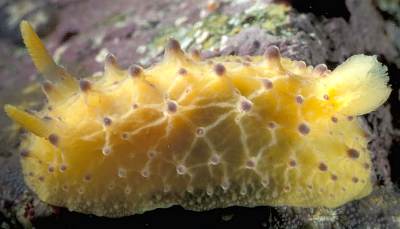
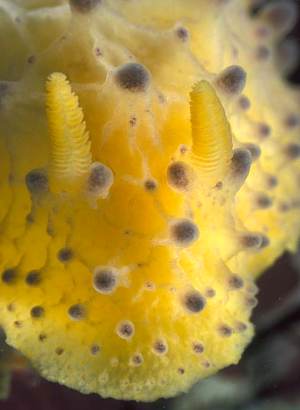
Doris sticta
(Iredale & O'Donoghue, 1923)
Order: NUDIBRANCHIA
Suborder: DORIDINA
Superfamily: EUDORIDOIDEA
Family: Dorididae
DISTRIBUTION
The species has been recorded sublittorally around South Wales, Lundy and the Scilly Isles. The greater part of its range extends southwards from northern Brittany to Morocco and the Mediterranean Sea (Iredale & O'Donoghue, 1923).
PHOTO
south coast Guernsey, (English Channel, Great Britain (about 49 24 N and 002 38 W)). June 30, 2003. Photos: Richard Lord
The background colour is translucent yellow. The mantle is covered in raised rounded tubercles, up to 3mm in diameter, which are interconnected by a radiating pattern of low ridges. The rounded tips of the tubercles are purplish grey and the complex network of ridges are a translucent white. The rhinophore pockets have a large tubercles on the inside edge and another on the outside. There are a number of similar tubercles around the edge of the branchial pocket. There are about 5 bipinnate or tripinnate gills. The head bears a pair of short, grooved oral tentacles. The front edge of the foot is bilaminate, the upper layer being entire, not notched. This uncommon species is large and conspicuous, reaching 45 mm in length. It was previously known as Doris maculata Garstang, 1895.
References:
• Iredale, T. & O'Donoghue, C.H. (1923). List of British nudibranchiate Mollusca. Proc. Mal. Soc. London, 15(4): 195-200
• Thompson, T.E. (1988). Molluscs: Benthic Opisthobranchs (Mollusca: Gastropoda). Brill & Backhuys, Leiden. pp 1-356
Rudman, W.B., 2003 (July 9) Doris sticta (Iredale & O'Donoghue, 1923). [In] Sea Slug Forum. Australian Museum, Sydney. Available from http://www.seaslugforum.net/find/doristic
Related messages
Doris sticta from Scilly Isles
September 30, 2009
From: David Kipling
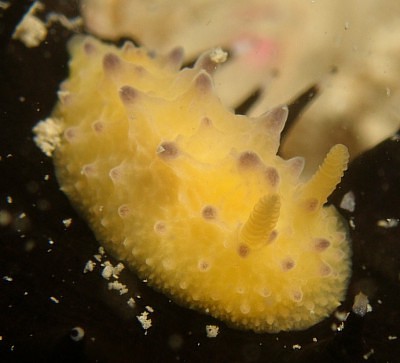
Dear Bill,
Here is a picture of Doris sticta that Sarah Bowen and I found on the Isles of Scilly recently. It was in a rich sponge environment.
Locality: Isles of Scilly, 49o 56.12 N 006o 15.59W, 25 m, United Kingdom, Atlantic, 1 May 2009, On a ledge in a steep rocky wall environment, a rich silty mixed sponge environment.. Photographer: David Kipling.
Do you have any clue as to what this species eats? I presume some type of sponge given the shape of the animal. The dark coloured spiky object that the animal is crawling over is in fact a very large holothurian, which made the nudibranch very easy to spot!
Best regards
David Kipling
plankton@dircon.co.uk
Kipling, D., 2009 (Sep 30) Doris sticta from Scilly Isles. [Message in] Sea Slug Forum. Australian Museum, Sydney. Available from http://www.seaslugforum.net/find/22610Dear David,
Thanks for the record. I'm afraid this is another species we know little about. According to Picton & Morrow (2009) there is no information available on what it eats. Presumably it is a sponge-feeder but whether or not it specialises on a particular species we just don't know.
-
Picton, B.E. & Morrow, C.C., 2009. [In] Encyclopedia of Marine Life of Britain and Ireland
http://www.habitas.org.uk/marinelife/species.asp?item=W13970
Best wishes,
Bill Rudman
Doris sticta from Guernsey
July 13, 2003
From: Richard Lord

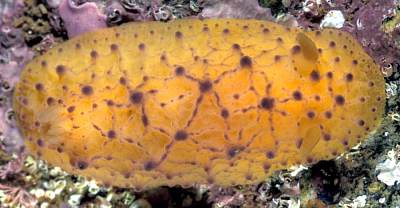
Dear Bill.
I regular receive opisthobranchs from crab potter Clive Brown who works strings of crab pots along Guernsey's south coast (English Channel, Great Britain (about 49 24 N and 002 38 W)). On June 30, 2003 Clive brought me two Doris sticta that were attached to each other. I placed them in an aquarium and they separated. I photographed the largest of them, which was about 4 cm long. The crab pot they entered was at a depth of 50 metres.
Best wishes,
Richard Lord
fishinfo@guernsey.net
Lord, R., 2003 (Jul 13) Doris sticta from Guernsey. [Message in] Sea Slug Forum. Australian Museum, Sydney. Available from http://www.seaslugforum.net/find/10401Dear Richard,
Thanks very much for these photos of an animal not yet represented on the Forum. It has a superficial resemblance externally to a species of Halgerda, but the bushy gills and raised rhinophore pockets are rather different. I have included a couple of close-ups to show the gills and rhinophores in a second message. Thanks also for the photos of the other nudibranchs for the crab pots which I will post in the next few days. Am I right in assuming thet are dragged in when the pots are being retrieved from the bottom?
Best wishes,
Bill Rudman
Doris sticta from Guernsey [2]
July 13, 2003
From: Richard Lord

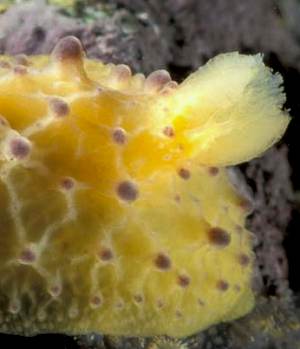
Dear Bill:
To accompany my message about Doris sticta from Guernsey, here are some close-ups to show anatomical details.
Yours sincerely,
Richard
fishinfo@guernsey.net
Lord, R., 2003 (Jul 13) Doris sticta from Guernsey [2]. [Message in] Sea Slug Forum. Australian Museum, Sydney. Available from http://www.seaslugforum.net/find/10439Thanks Richard,
Bill Rudman
